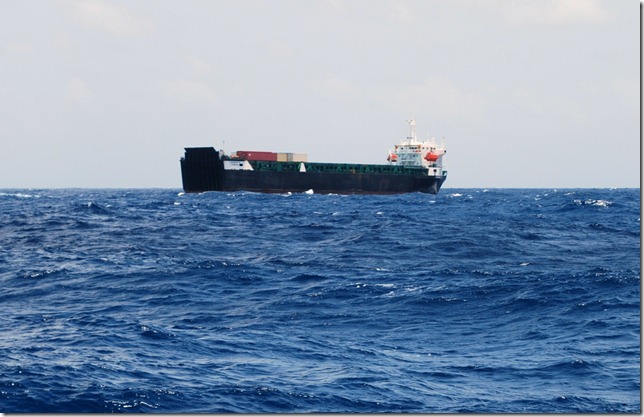Lat: 8 31.419′ N
Lon: 49 12.110′ W
Well, it’s been almost two weeks since we left Brazil, but frankly, it feels more like two months. I think there are several reasons for this, one of them being that we are nearing the finish line in terms of our circumnavigation and, like a marathon runner in the 25th mile, we are getting pretty weary but must press on. There also hasn’t been much to break up the monotony on board. Our radio friends have all reached their Caribbean destinations and no longer tune in, nor have we been able to pick up any news on the radio. It has just been us and the flying fish — until last night, that is.
Dallas had warned me before my watch last night that we had entered shipping lanes. Early on, I saw the glow of a couple of ships on the horizon but could not pick them up on the AIS. Without the AIS, we must rely on good old fashioned eyesight. We line up the boat (using its lights at night) with a fixed point on our boat (e.g., the port bow) and then monitor the changes of the boats’ lights relative to that fixed point to see if the boat is moving forward or aft of us, for example.
So around midnight, I began to monitor a glow on the horizon that was lined up with our bow. Unfortunately, after 20 minutes of monitoring, the glow had turned into multiple bright lights, and the lights’ position had not changed relative to our bow, indicating that we were on a collision course. This continued even after I altered our course by 10 degrees to starboard. I tried hailing them on the VHF ("vessel at appromixate position…do you copy?") but received no response, so I woke Dallas up for moral support. He tried hailing them as well using both English and Spanish ("barco grande"?) but to no avail. By now the lights were very bright, and the way they bobbled through the water toward us, they appeared to be fixed to some aquatic spaceship. This was clearly a large fishing boat rather than a cargo ship, which would have had fewer lights that would have indicated its direction (e.g., red for port side) rather than just being lit up to high heaven. Dallas and I were worried enough about the possibility of collision that we put on our life vests as we continued to stare at them through the binoculars and try to determine the most appropriate course of action. Eventually we decided that a sharp turn to port would be best and used the port engine to help make it happen. A few minutes later, the monstrosity passed our starboard bow and bobbled off into the night.
As my adrenaline levels dropped, I hoped we wouldn’t have to deal with that again anytime soon, but I was a little too optimistic (not the first time, LOL). Around 11 a.m, we had more or less the same thing happen, this time with an unusually small container ship. Dallas tried hailing them on the radio in various languages with no reply. In the daylight, it was easier to determine the ship’s trajectory, so we altered course a little sooner, but again, if we hadn’t… The AIS happened to kick in as we were clearing the ship and informed us that we were about a third of a mile from it. That sounds like a lot, but when you are at the mercy of factors beyond your control such as wind, seas, and current, you need this much leeway. And it doesn’t seem like too much to ask given the enormity of the surrounding ocean!
We have heard that ships’ captains can be penalized if they bring their ship within a half mile of another vessel. However, it seems that there are so few sailing boats out here that rather than keeping watch, captains tend to rely on radar and AIS, which don’t always pick up the smaller vessels. Another case in point was the near miss that our Frenchy friends on S/V RDJ had with a cargo ship between South Africa and Namibia. Unfortunately they had to turn into the wind to avoid the cargo ship and ended up tearing their jib in the process. The captain of the ship radioed afterward to apologize, saying he saw them only after they changed course. The rules of the sea require that motor vessels give way to those under sail, but obviously that is not to be relied on!
OK, time to get off my soapbox and start looking out for more traffic. On a positive note, the wind is coming more from the quarter, so the motion is much better, and we’re making pretty good speed despite a little bit of counter-current. Less than 700 miles left…


